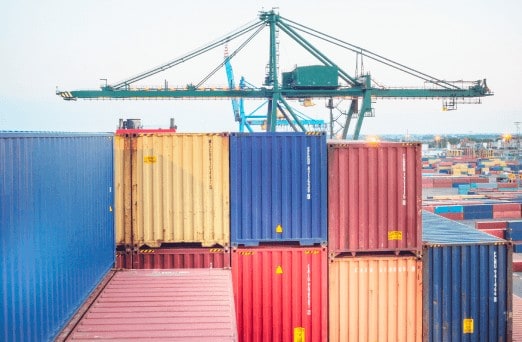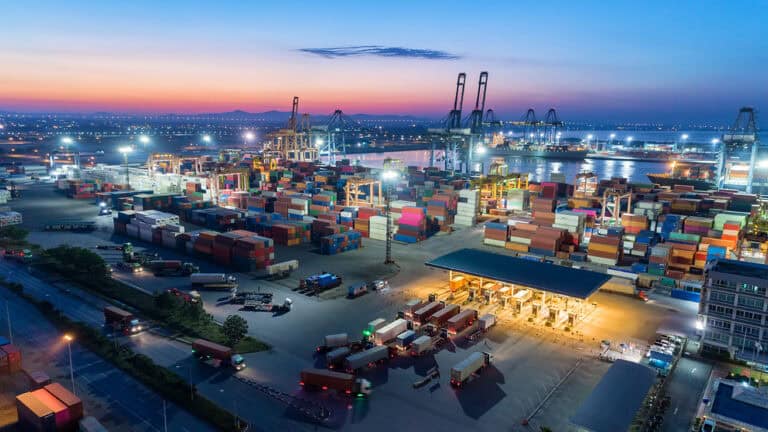
TMS software simplifies complex logistics processes and helps companies reduce transportation spending by optimizing freight shipments across multiple carriers and different transport modes (ocean, air, road, rail). The systems also help companies reduce their carbon footprint, improve on-time delivery, and provide visibility of goods in transit.
The first commercial transportation management system software was introduced in the early 1990s. Since then, TMS has become a critical supply chain management system for manufacturers, retailers, and distributors of all sizes.
What is a transportation management system?
A Transportation Management System is a software application that is used by businesses to manage all aspects of shipping materials, components, and finished goods using external freight carriers or an internal fleet. For global companies with complex logistics, TMS is essential for effective planning and efficient execution of transportation functions.
State-of-the-art transportation management systems are cloud-based, providing faster deployment and lower costs to install and operate. They provide direct communication and integration with freight carriers, and some TMS systems give shippers access to carrier networks with thousands of pre-screened carriers, easing the selection and management of multiple cargo carriers.
The costs for TMS software can vary widely depending on the complexity of a company’s transportation operations, the number of shipping locations, and their shipping volumes. Cloud-based transportation management systems are typically licensed under a Software-as-a-Service (SaaS) model, with annual license fees based on usage, number of users (or seats), or tiered pricing.
TMS transportation management system software integrates with other supply chain management systems and enterprise software, including ERP, warehouse management systems (WMS), and order management systems.
For businesses that ship products across borders, transportation supply chain systems also integrate with global trade management software to better coordinate transportation logistics with customs clearance and trade compliance.
What are the main benefits of a transportation management system?
Companies rely on transportation management systems (TMS) to optimize transport spend, improve the efficiency of their shipping operations, and ensure on-time, in-full delivery to enhance customer satisfaction and reduce chargebacks and penalties. Best-in-class TMS systems also help companies minimize their carbon footprint by including emissions calculations alongside cost and other variables when selecting freight carriers.
Improved visibility
TMS provides real-time transportation visibility into the status and location of shipments, allowing logistics teams to track them as they move through the supply chain, helping to reduce delays, prevent disruptions, and optimize transportation routes.
Increased efficiency
Using a TMS streamlines transportation operations by automating many of the manual processes involved in logistics management, reducing the risk of errors, saving time, and allowing logistics teams to focus on higher-value tasks.
Cost savings
By optimizing routes, consolidating shipments, and reducing the need for expedited or emergency shipping, a TMS system reduces transportation costs. The savings can be significant, particularly for global logistics operations.
Better collaboration
Companies that use a TMS experience better collaboration between logistics teams and external partners, such as carriers and suppliers, improving communication, increasing efficiency, and reducing the risk of errors or delays.
Compliance
TMS helps to ensure compliance with regulatory requirements and industry standards, such as safety regulations, environmental regulations, and customs requirements, reducing the risk of penalties or fines, and helping to maintain a positive company reputation.
Improved customer service
Better data and planning help companies meet customer delivery expectations and provide more accurate and timely information about shipment status and delivery times.
Reduced carbon footprint
TMS allows companies to compare the emissions footprint of different transport scenarios before booking freight. By including emissions in their decision-making, companies can reduce the environmental impact of their transport decisions.
What are the main functions of a transportation management system?
The main functions of a TMS are freight planning, shipment execution, carrier procurement and management, and reporting. A complete transportation logistics solution also includes carrier audit and settlement, vehicle routing and scheduling, transportation forecasting, and equipment management (for shipping containers).
Freight planning
Plan and manage transportation requirements based on current and planned orders. Identify the best mode of transportation, the most cost-effective route, and the most appropriate carrier to use based on contracted routing guides. Advanced TMS systems optimize overall efficiency by consolidating loads and automatically comparing rates, capacity, emissions, and other criteria to determine the best carrier for each load.
Shipment execution and tracking
Tender, book, schedule, and track shipments from the time they leave one facility until they arrive at their destination. Modern transportation management systems provide integration with freight carriers to minimize manual steps in booking transportation.
Carrier management
Manage the end-to-end relationships with freight carriers including procurement (RFP) and selection, contracting, and routing guide compliance.
Reporting and analytics
In addition to real-time visibility into transportation operations, transportation management systems provide historical reporting and analytics to understand trends, monitor carrier performance and identify improvement opportunities.
Carrier audit and settlement
Automate the process of comparing freight invoices to contracted rates and services to identify discrepancies prior to payment. Payments for approved invoices can be initiated through integration with accounts payable systems.
Vehicle routing and scheduling
Dynamic automated planning, loading, and routing improve the utilization of drivers and vehicles. Mobile driver applications connect dispatchers to drivers, provide turn-by-turn navigation, and electronic signature capture for Proof of Delivery.
Do transportation management systems support all modes of transportation?
Earlier generations of TMS software only supported a single transport mode (rail or truck, for example), which often created blindspots, delays, and inefficiencies in logistics. Today’s best-in-class TMS systems can support multiple modes of transportation providing end-to-end logistics visibility, improved reliability, and efficiency.
Network-based transportation management systems also make it easier and more efficient for shippers to connect to more carriers, providing greater flexibility and cost savings.
Transportation management system for road transportation
Road freight is the principal means of shipping in national and regional markets using commercial trucking companies for LTL (less-than-truckload) and FTL (full-truckload) shipments. Key TMS capabilities for road transportation include the ability to manage contracts and shipping with multiple carriers through automated tendering and booking using negotiated rates and schedules.
Many shippers also rely on spot markets to handle shipment volumes beyond those of their contracted carriers. Not all systems support spot market transactions, so shippers may need to manage these transactions manually, outside of the TMS. Systems that are connected to a carrier marketplace simplify spot-market transactions either directly with carriers or through integration with leading freight brokers.
Transportation management for parcel shipping and e-commerce fulfillment
The growth of ecommerce over the the past two decades has created a need for TMS systems that can meet the unique needs for package and small parcel shipping. In addition to real-time rate-shopping across carriers, shippers using different carriers (FedEx, DHL) need the ability to meet each carrier’s specific labelling and manifesting requirements. The shipping and documentation challenges are multiplied as cross-border ecommerce continues to grow.
Transportation management system for rail transportation
Shippers using rail transportation face unique challenges in optimizing freight rates. In addition to automating the shipping process, a TMS can allow shippers to reduce the end-to-end rates they pay for shipments that use multiple railways, rather than relying on carrier through-rates.
Transportation management for air transportation
In addition to automated planning and booking capabilities, TMS for air transportation manages complex security and regulatory requirements, including restrictions on hazardous materials. For international shipments subject to trade regulations, the systems can automate compliance and screening for dual-use goods, restricted or sanctioned parties, and destination controls.
Transportation management for ocean cargo
Like air transport, ocean transportation is subject to unique regulatory requirements and shipping documentation, including verified gross mass data (VGM) and customs documentation (for international shipments). Systems supporting ocean transport simplify bookings with a common interface to carriers and non-vessel operating common carriers (NVOCC).
Transportation management for multimodal and intermodal transport
Intermodal refers to shipments that use multiple modes of transport, that are booked separately with a separate bill of lading for each leg and mode of the journey.
Multimodal refers to shipments that are booked and shipped under a single bill of lading, with one carrier managing every leg and mode of the journey.
Who uses a TMS?
TMS software is used by manufacturers, retailers and e-commerce companies, wholesale distributors, logistics service providers (including 3PLs and 4PLs), freight forwarders, and shipping companies operating their own fleets of ships, planes, and trucks.
Transportation management for shippers
By far the largest usage of TMS software is by companies that manage their own shipping either using outside carriers or an internal fleet. Some industries have specific transportation requirements, such as cold-chain logistics for some foods and pharmaceuticals.
Major TMS users include:
- Automotive, industrial, and high tech manufacturers
- Bio-pharma and healthcare products manufacturers
- Food, beverage, and consumer packaged goods (CPG) companies
- Industrial, medical, and other wholesale distributors (B2B)
- Grocery retailers and wholesale distributors
- Apparel and general merchandise retailers
- E-commerce companies
TMS for freight forwarders
Freight forwarders have their own set of TMS requirements for managing shipments for multiple customers across all modes and geographies. A TMS for freight forwarders has unique workflows and capabilities for handling multiple languages, currencies, and time zones. Similar to TMS for shippers, a TMS helps forwarders reduce the cost and time it takes to handle each shipment, resulting in better customer service and the ability to differentiate their business in a competitive market.
TMS for logistics service providers and 3PLs
Third-party logistics service providers (LSPs) must manage sophisticated requirements for multiple clients while controlling costs in a highly competitive market. Specialized Transportation Management systems help LSPs manage the entire logistics operation from front to back, handling multiple languages, currencies, and time zones. TMS for LSPs should include or integrate with cross-dock and warehousing capabilities to help manage all multimodal transportation and temporary storage activities for one shipment––and produce an itemized customer invoice.
TMS for freight carriers
Cargo or freight carriers rely on transportation management software to optimize their fleet operations, gain visibility, manage containers to minimize empty miles, navigate customs requirements, and provide booking and tracking for their customers. In addition, carriers that connect to a network TMS have opportunities to win new customers and grow their business within a freight marketplace.
About e2open Transportation Management
E2open Transportation Management is a connected TMS for all transportation modes around the globe, with support for parcel, less-than-truckload, and truckload shipping, and for managing inbound and outbound moves.
E2open simplifies and optimizes domestic and international logistics for shippers, freight forwarders, carriers, and logistics service providers (LSPs) by providing capabilities based on your specific needs so you can serve your customers better.
Our native cloud architecture reduces implementation time and accelerates time-to-value. The system provides a common user interface across modes and functions facilitating consistent communication and collaboration among internal teams, carriers, and other transportation services providers.
With e2open, shippers get access to a vast global carrier network, with more than 50,000 carriers across road, rail, ocean, and air. The e2open carrier marketplace simplifies the onboarding, selection, and management of carriers, with easy access to additional capacity at competitive market rates when needed.
For global companies, e2open Transportation Management integrates with e2open Global Trade and Supply Management applications to orchestrate end-to-end supply chain processes, with access to the world’s largest ecosystem of manufacturing, logistics, global trade, and distribution partners.
To learn more or request a demo, contact us today!







